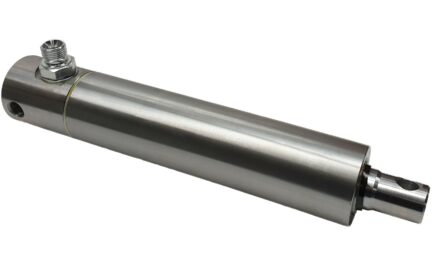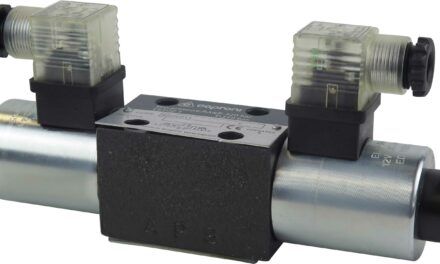What is the function of a lowering brake valve in hydraulics?
Overcenter valves (also known as counterbalance valves) are basically pilot-operated check valves with corresponding throttling and damping devices. These hydraulic valves regulate the lowering speed according to the volume flow supplied on the opposite side of the consumer.
Counterbalance valves are used when pulling loads must be held safely and moved in a controlled manner. To do this, the lowering brake valve is preloaded to a higher pressure than that corresponding to the largest permissible load.

Counterbalance valves are often used as safety valves, therefore a rigid connection to the consumer (hydraulic cylinder or hydraulic motor) is necessary. No hose line may be used between the valve and the consumer.
The following must be observed for hydraulic motors : Due to the function-related leakage, it is not possible to hold the load at standstill. In such an application, an additional holding brake must be used. This is hydraulically ventilated when the hydraulic motor is started up.
Typical applications for lowering brake valves are e.g. cable winches, lifting platforms, cranes etc.
Hydraulic circuit diagram of a lowering brake valve:

Single-acting counterbalance valve
Single-acting counterbalance valves are only suitable for one direction of action of a consumer. For hydraulic cylinders, for example, these are only pulling loads. The same applies to hydraulic motors, e.g. for cable winches. The circuit diagram shows a single-acting lowering brake valve for a hydraulic motor (acting in port “A”). Port “C” is also provided. The release connection of a hydraulically releasable multi-disc brake is connected here.

Double-acting counterbalance valve
Double-acting counterbalance valves act in both directions of rotation on hydraulic motors. In hydraulic cylinders, double-acting valves function with both pulling and pushing loads. The circuit diagram shows the double-acting lowering brake valve for a hydraulic motor. The brake release connection “C” is also additionally present here.

What does the open ratio mean for a counterbalance valve?
The lift ratio indicates the ratio between the pressure boundary surface and the lift surface. Thus, the lift ratio is the lift area divided by the pressure boundary area.
Example: A counterbalance valve has an open ratio of 4:1. The pressure setting of the valve is 210 bar, the load is 140 bar. The required upstream pressure is then (210bar – 140 bar)/4 = 17.5 bar.
In general, small upstroke ratios provide more accurate and stable motion control. This is especially true for “unstable” drives with large loads. Higher lift ratios improve the efficiency in hydraulic drives (lower heat generation). Disadvantage: The higher drive ratio can have a negative effect on the stability and accuracy of the motion control.
Hydraulic motors usually use counterbalance valves with a slightly larger open ratio. As mentioned above, hydraulic unlockable parking brakes should be used on hydraulic motors to hold loads.
How to adjust a lowering brake valve?
In order for lowering brake valves to function properly, they must be set correctly. The setting should be at least 1.3 times the expected load pressure. Since lowering brake valves are a safety device, the adjustment may only be carried out by trained personnel! The correct adjustment can be performed in the hydraulic system and is done in 6 steps:
- Set the counterbalance valve to maximum pressure, observing the direction of rotation of the adjusting screw (see manufacturer’s instructions).
- Lifting the load by a few millimeters by means of the hydraulic system. If the load is lifted too far, there is a risk that the fitter will injure himself during the adjustment process.
- Switch off the hydraulic system. The valve must not be subjected to the control pressure during the adjustment process. Then mark the position of the hydraulic cylinder with a waterproof pen or similar.
- Preliminary setting of the lowering brake valve exactly to the load pressure. To do this, very slowly reduce the pressure setting on the valve (observe the direction of rotation). As soon as the piston rod of the cylinder moves, the pressure setting is increased again until the load stops again. If the set pressure is reduced too quickly, the load will drop abruptly when the load pressure is reached. This can damage the mechanics when using multiple cylinders.
- The pressure setting in the lowering brake valve increases proportionally with the spring preload (approximately linear increase). Therefore, the preload can be increased by ⅓ when adjusting to the load pressure.
This is done as follows:
First, count how many turns the valve is preloaded to keep the load straight. It should be noted that the load must be secured against unintentional lowering beforehand.
Then turn the valve fully open (minimum pressure setting), counting the revolutions exactly. Then screw the adjusting screw back in by the previously counted turns and add 30% to achieve the desired safety of 1.3 times the load pressure. Example: The number of turns to hold the load is 5 turns. To achieve 1.3 times the load pressure, the number of revolutions is then 5 + 30% = 6.5 revolutions - Securing the setting: Finally, secure the setting screw against unauthorized adjustment. This can be done by sealing or with screw locking varnish.
What is the difference between a lowering brake valve and a load holding valve?
Counterbalance valves are also referred to as counterbalance holding valves. A check valve is integrated into the valve, which takes over the load holding function.

A hydraulically pilot-operated check valve is used purely as a load holding valve, with no braking effect on pulling loads. This check valve therefore has a purely holding function and is used in all areas of hydraulics where a load must be held. The unlock function is required to lower the load.

Countersunk Brake Valve Manufacturer
There is a wide range of suppliers for lowering brake valves. The table shows a selection of some of the best-known manufacturers:






